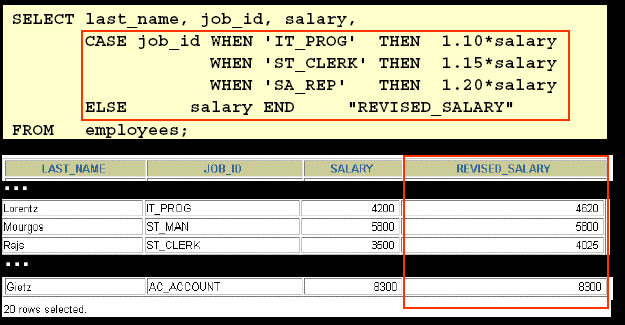>字符处理
upper(str)---将字符串str全部转换成大写
lower(str)---将字符串str全部转换成小写
initcap(str)---将字符串中每个单词的首字母大写
concat(str1,str2)---将字符串str1与str2连接起来(也可以通过'||'号直接相连)
substr(str,a,b)---取字符串str中的指定字符,从位置a开始取长度为b的字符串,假如a为正则从左边开始,否则从右边开始
instr(str,'z')---取得str字符串中从左边开始每一次出现z字符的下标位置(下标从1开始)
lpad(str,12,'*')---左填充,即将字符串str长度填充到12,假如其不足12位则在左边以*号填充
rpad(str,12,'*')---右填充,同上
length(str)---计算字符串str的长度
2>数字函数
round(45.926,2)---将前一数保留指定的小数位,并四舍五入(45.93),假如指定位是负数则意为在小数点左边保留指定位,如round(45.923,-1)=50,rount(45.923,0)=46,round(45.93,-2)=0,round(55.93,-2)=100
trunc(45.926,2)---同上,得不四舍五入(45.92)
mod(1600,300)---求余(100)
3>日期型函数
oracle中默认的格式是:DD-MON-RR。
oracle中有个到当前系统时间--sysdate,如:
select sysdate from dual
可对日期进行自述运算:
select (sysdate-mybirthday)/7 from person
months_between('01-sep-95','11-jan-94')---取得二个日期之间的间隔月数(19.6774194)
add_months('11-jan-94',6)---给指定日期加上指定的月份后得到一个新的日期(11-jul-94)
next_day('01-sep-85','friday')---取得当前日期中下个周五的日期(01-jul-95)
last_day('01-feb-95')---取得当前日期中月份的最后一天(28-feb-95)
round进行四舍五入,trunc则否,以下是我的操作结果:
sysdate为:
SYSDATE
----------
28-7月 -06
select
round(sysdate,'month') RM,
round(sysdate,'year') RY,
trunc(sysdate,'month') TM,
trunc(sysdate,'year') TY
from dual;
RM RY TM TY
---------- ---------- ---------- ----------
01-8月 -06 01-1月 -07 01-7月 -06 01-1月 -06
4>转换函数
隐式转换:系统自动转换,如:
varchar2 or char to number
varchar2 or char to date
number to varchar2
date to varchar2
显式转换:人为以函数加以转换
日期,字符,数据三者之间可以相互转换:日期<-->字符<-->数据
日期格式:YYYY
日期-->字符
select to_char(sysdate,'yyyy-mm-dd') ch from dual
CH
----------
2006-07-28
数字-->字符
to_char(number,'format_model'),oramat_model有如下:
9---用对应数字表示
0---强制用0表示
$---加一$符号
L---前加本地货币单位表示
.---十进制点
,---千进制点
select to_char(0917,'l9999.99') local from dual
LOCAL
------------------
RMB917.00
字符-->日期
tselect to_date('19830917','yyyy-mm-dd') bir from dual
BIR
----------
17-9月 -83
字符-->数字
select to_number('19821217','999999999') mybr from dual
MYBR
----------
19821217
注:所有函数均可以嵌套使用
5>通用函数
nvl(expr1,expr2)---expr1为空则显示expr2,否则显示expr1
nvl2(expr1,expr2,expr3)---expr1为空则显示expr2,否则显示expr3
nullif(expr1,expr2)---二个相等则显示空符,否则显示expr1
coalesce(expr1,expr2,...,exprn)---从expr1开始依次找到不为空的expr,找到就显示,直到最后,否则显
示exprn
case表达式,如下图:

6>多表查询
对普通的多表查询,也就是不加where条件的时候实际上查询结果是各表的笛卡尔集
外连接:oracle实现外连接时在=号的二边加+号就OK,当+在左边时称为右连接,反之为左连接,它常常用来当要求未受限制对象的表数据也要求显示时,如下:
select * from student
ID NAME ADDRESS
-------------------- --------------
1 zhangshan zhejiang
3 lishi hangzhou
7 lily guangzhou
select * from person
ID NAME ADDRESS
- -------------------- -----------
1 zhangshan zhejiang
3 lishi hangzhou
7 lily guangzhou
select p.id,p.sex,s.id,s.name,s.address from person p ,student s where p.id(+) = s.id
ID SEX ID NAME ADDRESS
-- ---- ---------- -------------------- ------------
1 boy 1 zhangshan zhejiang
3 girl 3 lishi hangzhou
7 lily guangzhou
select p.id,p.sex,s.id,s.name,s.address from person p ,student s where p.id = s.id(+)
ID SEX ID NAME ADDRESS
-- ---- ---------- -------------------- --------------
1 boy 1 zhangshan zhejiang
2 girl
3 girl 3 lishi hangzhou
4 boy
5 girl
self-join,就是同一张表连接,用自连接的时候要注意排除重复的记录(自身,循环重复等),比如说找出student表中所有住在同一个地方的人。
select * from student
ID NAME ADDRESS
--- -------------------- ---------
1 zhangshan zhejiang
3 lishi hangzhou
7 lily guangzhou
2 name2 guangzhou
4 name4 guangzhou
5 name5 hangzhou
6 name6 shanghai
8 name8 shanghai
没有排除重复记录时的结果:
select t1.name,t2.name
from student t1, student t2
where t1.address = t2.address
NAME NAME
-------------------- --------------
lily lily
name2 lily
name4 lily
lily name2
name2 name2
name4 name2
lily name4
name2 name4
name4 name4
lishi lishi
name5 lishi
NAME NAME
-------------------- --------------
lishi name5
name5 name5
name6 name6
name8 name6
name6 name8
name8 name8
zhangshan zhangshan
已选择18行
排除重复与循环记录之后:
select t1.name,t2.name,t1.address
from student t1, student t2
where t1.address = t2.address
and t1.id > t2.id
NAME NAME ADDRESS
-------------------- -------------------- -------------------
lily name2 guangzhou
name4 name2 guangzhou
lily name4 guangzhou
name5 lishi hangzhou
name8 name6 shanghai
cross join,无条件连接,实际上跟不带where时一样得到的是笛卡尔集
natural join(也可以直接记作join),根据表中同名栏位来连接记录,若表中可能出现多个同名栏位,则用using(col_name)来指定所栏位。colname不能指定表的别名!限制条件用on来指定
select id,p.sex,id,s.name from person p join student s using(id);
ID SEX ID NAME
---- ---- ---------- --------------------
1 boy 1 zhangshan
2 girl 2 name2
3 girl 3 lishi
4 boy 4 name4
5 girl 5 name5
在sql标准语法中,左(右)连接用left(right) out join,限制条件用on就可以了。
full out join完全外连接,顾名思义就是左外连接与右外连接都有
select id,p.sex,id,s.name from person p full join student s using(id);
ID SEX ID NAME
---- ---- ---------- ------------------
1 boy 1 zhangshan
3 girl 3 lishi
2 girl 2 name2
4 boy 4 name4
5 girl 5 name5
8 8 name8
6 6 name6
7 7 lily
翻译自:http://mfm088.itpub.net/post/22599/250400
在Oracle/PLSQL中,lpad函数将左边的字符串填充一些特定的字符,其语法格式如下:
lpad( string1, padded_length, [ pad_string ] )
其中string1是需要粘贴字符的字符串
padded_length是返回的字符串的数量,如果这个数量比原字符串的长度要短,lpad函数将会把字符串截取成padded_length;
pad_string是个可选参数,这个字符串是要粘贴到string1的左边,如果这个参数未写,lpad函数将会在string1的左边粘贴空格。
例如:
| lpad('tech', 7); |
将返回' tech' |
| lpad('tech', 2); |
将返回'te' |
| lpad('tech', 8, '0'); |
将返回'0000tech' |
| lpad('tech on the net', 15, 'z'); |
将返回 'tech on the net' |
| lpad('tech on the net', 16, 'z'); |
将返回 'ztech on the net' |
-----------------------
select a.*, Level from (select * from dlsys.tcUnit order by DisplayOrder) a
start with a.SeniorUnitID is null
connect by a.SeniorUnitID = prior a.UnitID